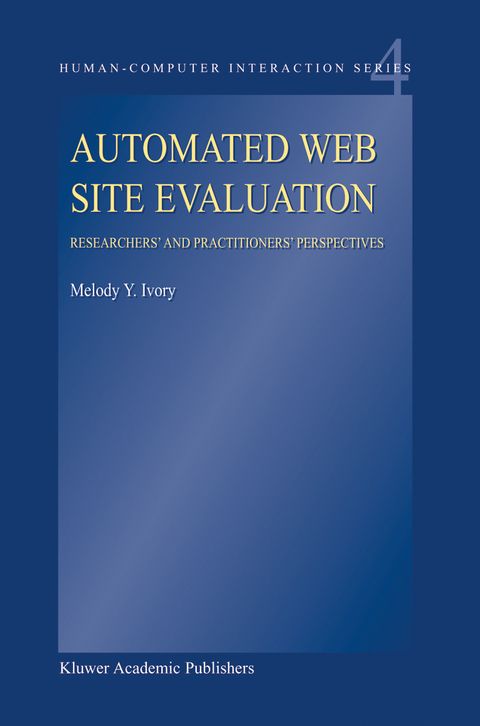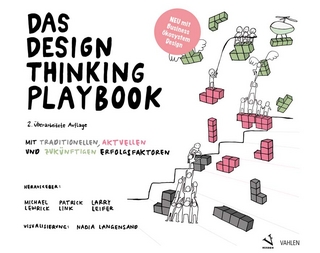
Automated Web Site Evaluation
Researchers’ and Practioners’ Perspectives
Seiten
2003
|
2003 ed.
Springer-Verlag New York Inc.
978-1-4020-1672-1 (ISBN)
Springer-Verlag New York Inc.
978-1-4020-1672-1 (ISBN)
Among all information systems that are nowadays available, web sites are definitely the ones having the widest potential audience and the most significant impact on the everyday life of people. Web sites contribute largely to the information society: they provide visitors with a large array of services and information and allow them to perform various tasks without prior assumptions about their computer literacy. Web sites are assumed to be accessible and usable to the widest possible audience. Consequently, usability has been recognized as a critical success factor for web sites of every kind. Beyond this universal recognition, usability still remains a notion that is hard to grasp. Summative evaluation methods have been introduced to identify potential usability problems to assess the quality of web sites. However, summative evaluation remains limited in impact as it does not necessarily deliver constructive comments to web site designers and developers on how to solve the usability problems. Formative evaluation methods have been introduced to address this issue. Evaluation remains a process that is hard to drive and perform, while its potential impact is probably maximal for the benefit of the final user. This complexity is exacerbated when web sites are very large, potentially up to several hundreds of thousands of pages, thus leading to a situation where eval uating the web site is almost impossible to conduct manually. Therefore, many attempts have been made to support evaluation with: • Models that capture some characteristics of the web site of interest.
I Background.- 1. Work Practices of Web Practitioners.- II Researcher’s Perspective.- 2. Automated Evaluation Methods.- 3. Usability Testing Methods.- 4. Inspection Methods.- 5. Inquiry Methods.- 6. Analytical Modeling Methods.- 7. Simulation Methods.- 8. The WebTango Method.- 9. Promising Research Directions.- III Practitioner’s Perspective.- 10. Automated Evaluation Tools.- 11. Comparison of Guideline Review Tools.- 12. Empirical Study of Guideline Review Tools.- 13. Analysis of Web Design Guidelines.- 14. Promising Tool Development Directions.- Appendices.- Appendix A: Web Site Evaluation Methodologies and Tools.- References.- About the Author.
| Erscheint lt. Verlag | 31.10.2003 |
|---|---|
| Reihe/Serie | Human-Computer Interaction Series ; 4 |
| Zusatzinfo | 50 Illustrations, black and white; XXVI, 201 p. 50 illus. |
| Verlagsort | New York, NY |
| Sprache | englisch |
| Maße | 160 x 240 mm |
| Themenwelt | Mathematik / Informatik ► Informatik ► Betriebssysteme / Server |
| Mathematik / Informatik ► Informatik ► Grafik / Design | |
| Informatik ► Software Entwicklung ► User Interfaces (HCI) | |
| Informatik ► Theorie / Studium ► Künstliche Intelligenz / Robotik | |
| ISBN-10 | 1-4020-1672-7 / 1402016727 |
| ISBN-13 | 978-1-4020-1672-1 / 9781402016721 |
| Zustand | Neuware |
| Informationen gemäß Produktsicherheitsverordnung (GPSR) | |
| Haben Sie eine Frage zum Produkt? |
Mehr entdecken
aus dem Bereich
aus dem Bereich
Mit traditionellen, aktuellen und zukünftigen Erfolgsfaktoren
Buch | Softcover (2018)
Franz Vahlen (Verlag)
CHF 41,70
Aus- und Weiterbildung nach iSAQB-Standard zum Certified Professional …
Buch | Hardcover (2023)
dpunkt Verlag
CHF 48,85
Wissensverarbeitung - Neuronale Netze
Buch | Hardcover (2023)
Carl Hanser (Verlag)
CHF 48,95


